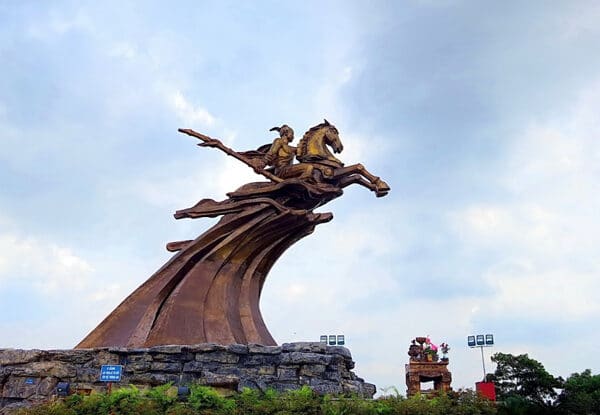Giong Temple in the past was a small temple built during the reign of King Dinh Tien Hoang and later built, repaired and appointed by King Le Dai Hanh to become Phu Dong Thien Vuong temple.
Giong Temple is not only associated with the history of the Vietnamese people but also associated with the legend of Thanh Giong, which is often passed down by folk.

Giong Temple is located in Soc mountain, Ve Linh commune, Soc Son. This is a complex of historical relics including Trinh temple, Non-Nuoc pagoda, Thuong temple, Mau temple (the place of worshiping Thanh Giong’s mother), Dai Bi pagoda, Chong stone, stele, and especially Thanh Giong statue. cast in pure copper. This relic population has been recognized by the State as a national level historical monument.
How to get to Giong temple from central Hanoi?
If you come from far away, you can book a flight to Hanoi, then choose the right means to get to Giong Temple.
Take the bus
From the Long Bien bus interchange, you take bus No. 15, the entrance to the Complex of Soc Son Temple is located near a bus stop. You can ask the bus staff to know where to get off.

About 3km from the junction to the Soc Temple, you can walk or call a motorbike taxi. However, since the temple grounds have a lot of walking, it’s best to call a motorbike taxi to save energy.
Take a motorbike or car
If you go from Co Loa, just go back to Highway 3 for more than 20km, there is a signboard showing the way to Soc Temple on the left.
Click here to view the route map from Hoan Kiem Lake (central Hanoi) to Giong Temple.
If you do not go through Co Loa but go straight to Soc Temple, there are also 2 options route:

The road going through Nhat Tan Bridge, do not turn to National Highway 5, but keep going straight until you meet Highway 18 (Phu Lo), turn right to Highway 18, continue to turn left onto Highway 3, go 1 more section will reach the junction with signposts to the Complex of Soc Temple Monuments.
The second road is the road passing Thang Long bridge towards Noi Bai airport, to the intersection with Highway 18, then follow Highway 18 around the back of Noi Bai airport, follow Route 131, until you meet Highway 3. turn left and go one more section to arrive.
Giong Temple historic site
Right from the entrance gate is Trinh Temple (also known as Ha Temple); where the statue of the mountain god is placed. This statue is cast entirely from bronze, weighing 7 tons with a very majestic manner. Outside the temple, there are also old banyan trees and a very green lake.

Passing through Trinh Temple is Dai Bi pagoda, an ancient pagoda with large panels, antiquated sentences painted in gilded and ancient architecture tinged with moss.
Opposite Dai Bi pagoda is Mau temple, where the statue is to worship Thanh Giong’s mother. The well outside the temple is also called Mother well.
From Mau Temple, going up a little more is to Thuong Temple, the last temple in the complex of 4 temples, the pagoda at the foot of Ve Linh mountain, is the place of worshiping Thanh Giong. In the temple there are Dai Bai and Hau Cung houses. Dai Bai’s house is decorated with matching sentences, parasols, cranes … are the typical features of the ancient pagoda architecture in Vietnam; Meanwhile, the Hau Cung set a statue to worship Thanh Giong made from agarwood.
From the gate of the monument going up, you will find a stone stele built entirely of slate. Those steles have existed for hundreds of years.
The most prominent feature in this relic is the statue of Thanh Giong on top of Da Chong mountain; Made entirely from pure copper, 11.07m high, weighing 85 tons. This statue was inaugurated in 2010, is one of the construction works to commemorate 1000 years of Thang Long. You can choose to hike up the stairs from the foot of the mountain, or rent a car to go straight to the top of the mountain following the path built on the side of the mountain.
From the statue of Thanh Giong going down, you can turn to visit Non Nuoc Pagoda at the height of 110m. Here you can the bronze statue of Buddha Tathagata is 8m high and weighs 30 tons.
Giong festival at Soc temple
Giong Festival is an annual festival held to commemorate the merit of the hero Giong in the past. The Giong Festival annually attracts thousands of visitors every year to watch the ceremony.

Along with that is a series of folk games such as swing competition, duck catching, Quan Ho singing, chess; volleyball tournament, mixed dance; performing traditional martial arts …
This festival has also been recognized by UNESCO as “the intangible cultural heritage of mankind”; and the beauty of traditional Vietnamese culture.


One thought on “Experience in traveling to Giong Temple (Soc Son district, Hanoi)”